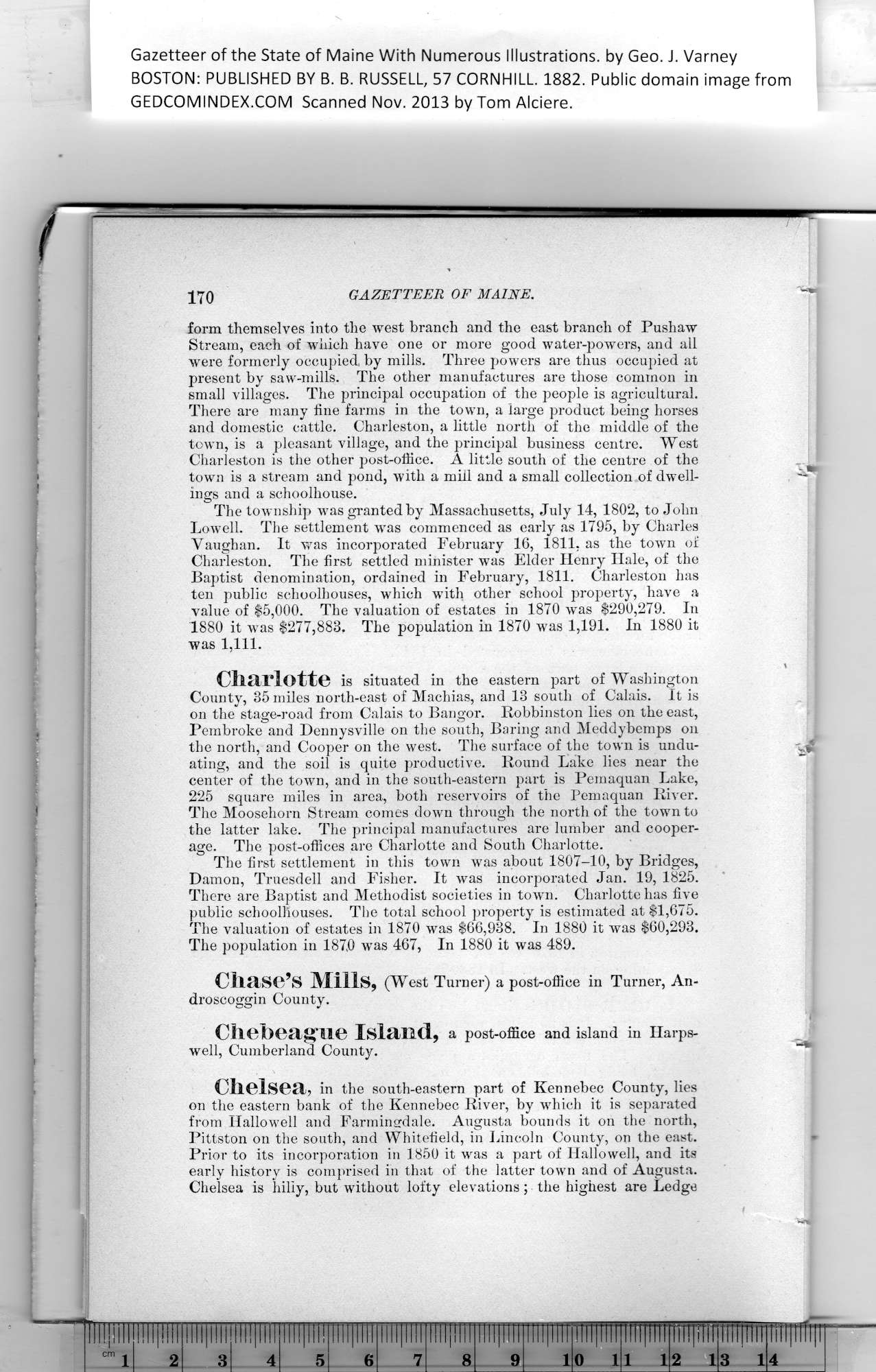|
Gazetteer of the State of Maine With Numerous Illustrations, by Geo. J. Varney
BOSTON: PUBLISHED BY B. B. RUSSELL, 57 CORNHILL. 1882. Public domain image from
170 GAZETTEER OF MAINE.
form themselves into the west branch and the east branch of Pushaw
Stream, each of which have one or more good water-powers, and all
were formerly occupied by mills. Three powers are thus occupied at
present by saw-mills. The other manufactures are those common in
small villages. The principal occupation of the jieople is agricultural.
There are many fine farms in the town, a large product being horses
and domestic cattle. Charleston, a little north of the middle of the
town, is a pleasant village, and the principal business centre. West
Charleston is the other post-office. A little south of the centre of the
town is a stream and pond, with a mill and a small collection of dwell-
ings and a schoolhouse.
The to wm ship was granted by Massachusetts, July 14, 1802, to John
Lowell. The settlement was commenced as early as 1795, by Charles
Vaughan. It was incorporated February 16, 1811, as the town of
Charleston. The first settled minister was Elder Henry Hale, of the
Baptist denomination, ordained in February, 1811. Charleston has
ten public schoolhouses, which with other school property, have a
value of $5,000. The valuation of estates in 1870 was $290,279. In
1880 it wras $277,883, The population in 1870 was 1,191. In 1880 it
was 1,111.
Charlotte is situated in the eastern part of Washington
County, 35 miles north-east of Machias, and 13 south of Calais. It is
on the stage-road from Calais to Bangor. Robbinston lies on the east,
Pembroke and Dennysville on the south, Baring and Meddybemps on
the north, and Cooper on the west. The surface of the town is undu-
ating, and the soil is quite productive. Round Lake lies near the
center of the town, and in the south-eastern part is Pemaquan Lake,
225 square miles in area, both reservoirs of the Pemaquan River.
The Moosehorn Stream comes down through the north of the town to
the latter lake. The principal manufactures are lumber and cooper-
age. The post-offices are Charlotte and South Charlotte.
The first settlement in this town was about 1807-10, by Bridges,
Damon, Truesdell and Fisher. It was incorporated Jan. 19, 1825.
There are Baptist and Methodist societies in town. Charlotte has five
public schoolhouses. The total school property is estimated at $1,675.
The valuation of estates in 1870 was $66,938. In 1880 it was $60,293.
The population in 187,0 was 467, In 1880 it was 489.
Chase’S Mills, (West Turner) a post-office in Turner, An-
droscoggin County.
Chebeagne Island, a post-office and island in Harps-
well, Cumberland County.
Chelsea, in the south-eastern part of Kennebec County, lies
on the eastern bank of the Kennebec River, by which it is separated
from Hallowell and Farminsrdale. Augusta bounds it on the north,
Pittston on the south, and Whitefield, in Lincoln County, on the east.
Prior to its incorporation in 1850 it was a part of Hallowell, and its
early history is comprised in that of the latter town and of Augusta.
Chelsea is hiliy, but without lofty elevations; the highest are Ledge
PREVIOUS PAGE ... NEXT PAGE
This page was written in HTML using a program written in Python 3.2
|
